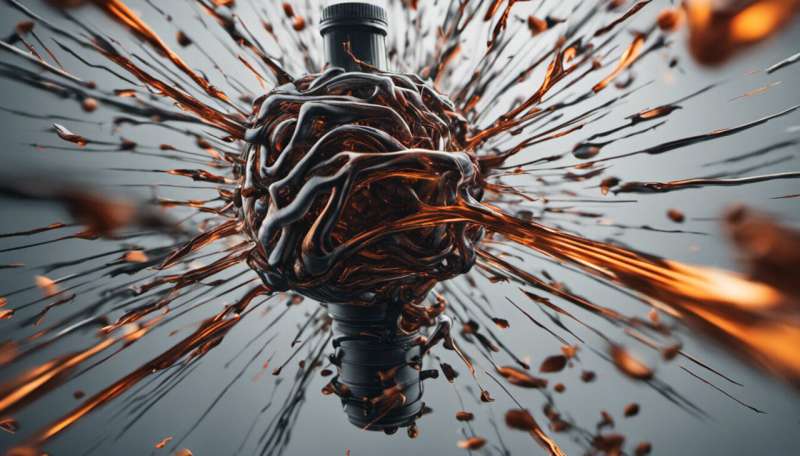This article has been reviewed according to Science X's editorial process and policies. Editors have highlighted the following attributes while ensuring the content's credibility:
fact-checked
trusted source
written by researcher(s)
proofread
Love or hate TikTok's viral bottle-smashing trend? A neuroscientist explains what that says about your brain

Millions of TikTok users are watching videos of the viral bottle-smashing trend, in which bottles and jars filled with drinks or food are rolled down steps before smashing.
Some of these viewers seem to be watching the videos for the autonomous sensory meridian response (ASMR) that the videos evoke, as many videos are uploaded accompanied by the hashtag #ASMR. While it might not be your idea of relaxing, for some viewers, the tinkling sound of breaking glass combined with the image of the bottle breaking are perceived as satisfying and even soothing.
ASMR is often described as a relaxing, tingling sensation experienced in the scalp or the spine. Videos that aim to trigger ASMR feelings grew in popularity a few years ago and there are now millions of YouTube clips of people whispering or tapping nails on an object, creating sounds that some people find pleasant.
While the videos are usually multi-sensory (they contain both visual and auditory information) it is primarily the audio component—the gentle, typically low-frequency sounds produced—that seems to lead some viewers to experience ASMR.
ASMR research
ASMR is being studied in psychology laboratories while researchers try to discern what exactly might be happening in the brains of people who enjoy these videos.
Research into the electrical activity of the brain may shed some light on the neurophysiology that underpins ASMR experiences. One tool used for this is electroencephalography (EEG), which uses sensors in a cap to measure the electrical activity produced by the brain. The electrical activity of the brain can be faster (higher frequency) or slower (lower frequency) depending on what someone is doing and how they are feeling.
Using EEG, researchers have measured the brain's electrical activity as participants watch ASMR-inducing videos and report changes in their state of relaxation.
Typically, lower-frequency activity in the brain is associated with a more relaxed brain state. It was observed that ASMR-inducing videos corresponded to reductions in the higher-frequency electrical activity of the brain and increases in the lower-frequency electrical activity. Increases in lower-frequency activity appeared to be maintained for 45 minutes after viewing ASMR-inducing videos.
The data suggests, therefore, that ASMR-inducing videos—such as those from the bottle-smashing trend—may indeed be influencing the state of the brain, leading to feelings of relaxation in ASMR-prone viewers. Interestingly, one of the reasons that ASMR videos have gained such popularity is their ability to influence relaxation. Research indicates that ASMR-prone people may also tend to experience anxiety and that ASMR-inducing videos may help to alleviate it.
What it means if you don't like bottle-smashing videos
But bottle-smashing videos don't leave everyone feeling relaxed. Some viewers report feelings of stress or sensory overwhelm. The extent of the negative response varies for different people, from mild irritation to rage.
Some people experience hyperacusis, where everyday sounds—such as something smashing—are perceived as loud and uncomfortable, even painful to listen to. Such experiences may be underpinned by increased levels of activity in parts of the brain that process sound.
Indeed, some people even experience misophonia, whereby some sounds lead to an intensely unpleasant emotional or physiological reaction, such as anger. The brain basis of misophonia is unclear, but it may relate to how strongly the auditory system of the brain is connected to the parts of the brain that process emotions.
Our experiences with sound can be thought of as existing on a spectrum, from ASMR-prone to misophonia-prone people. Both ends of the spectrum experience sound-based triggers, but the emotional consequences of such triggers are very different. This may in part explain why the same sound can yield very different feelings in different people when watching bottle-smashing videos.
For the bottle-smashing trend, there are additional non-auditory discomforts. Some viewers feel stressed by the anticipation of waiting for breakage. Others find the videos unpleasant due to the wasted contents of the bottle or jar.
What these videos serve to remind us of is just how individual our experience and interaction with the (auditory) world is—where one person's relaxation can be another person's rage.
This article is republished from The Conversation under a Creative Commons license. Read the original article.![]()





















